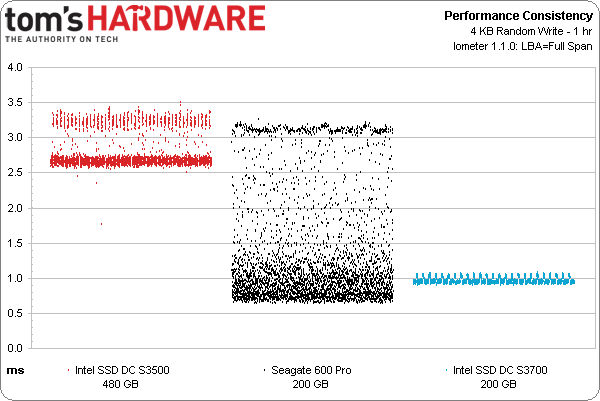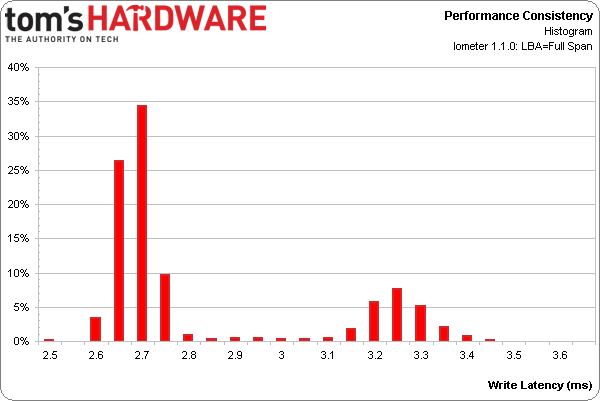The SSD DC S3500 Review: Intel's 6 Gb/s Controller And 20 nm NAND
As enterprise SSDs become more specialized and application-focused, Intel is hoping its SSD DC S3500 will strike a chord with customers looking for excellent read performance on a budget. We compare this drive to other notable contenders in its class.
Results: Performance Consistency
Increasingly, we pay close attention to the performance consistency of enterprise-class SSDs. This is what separates a good drive from a great one when all of the corner case testing seems equal. Over the past year, we measured this in terms of large-block transfers in our Enterprise Video Streaming section. Armed with that data and our exclusive analysis, the peaks, valleys, and frequency of each became clear. If you look at the information for long enough, you start to see fingerprints for each drive.
We started with large-block transfers because, in enterprise video applications, if you don't buffer or write data fast enough, you can lose it completely. Random 4 KB transfers are slightly more academic, but they also emulate database transfers pretty well. With this sort of workload, you might not actually lose anything, but your system will certainly slow down.
In the following tests, we subjected our enterprise SSDs to 25 hours of continuous random 4 KB writes across each drive. We recorded the IOPS every second, giving us 90,000 data points. We then zoomed in to the last 60 minutes to more coherently visualize the results.
As the graph clearly shows, Intel and Seagate take completely different approaches to latency. At one end, you have the SSD DC S3700, which delivers rock-solid performance with very little variation. On the other end, you have the S3500 that has higher latency and variance. When you zoom in on the data, though, the those "fingerprints" I mentioned earlier look almost identical. Even the histograms look similar. This comes as no surprise, since both Intel SSDs use the same controller.
Then there is Seagate's 600 Pro. Even though its average latency and IOPS are closer to the SSD DC S3700, the variance is so large that it approaches the maximum observed from Intel's SSD DC S3500.
A look at the histogram makes it easy to notice the two-level distribution of latency. Two peaks around 2.7 ms correlate to ~12,000 IOPS, while the peaks around 3.25 ms represent slightly less than 10,000 IOPS.
Intel makes it a point to specify the performance consistency of its enterprise SSDs. With the 480 GB SSD DC S3500, IOPS in the 99.9th slowest one-second interval should be within 75% of the overall average. In our testing, we recorded results closer to 80%.
Get Tom's Hardware's best news and in-depth reviews, straight to your inbox.
Current page: Results: Performance Consistency
Prev Page Results: 4 KB Random Performance And Latency Next Page Results: Enterprise Workload Performance-
Mastle Hi, Think there's an error on page 1, $579 for 80GB drive......Surely won't be getting it at that price for my home build!Reply -
busuan Found myself suddenly losing interests in SATA SSDs after seeing the specs of PCIe SSD in the latest MBA refresh.Reply -
PapaCrazy An Intel 320 series SSD I put in my dad's computer just encountered the 8mb bug even though the firmware was updated with the "fixed" version. He uses the computer for business and I got him an Intel SSD thinking it'd be reliable. I think I'm gonna try Samsung next time around.Reply -
Evolution2001 Nitpicking here... but the article text is still wrong...or the math is. :pReply
''...we do know that the 800 GB model we're reviewing should run around $579. At ~$1.20/GB, ...''
800GB @ $1.20 = $960. -
drewriley Reply10952175 said:Nitpicking here... but the article text is still wrong...or the math is. :p
''...we do know that the 800 GB model we're reviewing should run around $579. At ~$1.20/GB, ...''
800GB @ $1.20 = $960.
Thanks, just can't seem to get the right combination of 4, 8 and 0. The 480GB version is $579 -
drewriley Reply10952165 said:An Intel 320 series SSD I put in my dad's computer just encountered the 8mb bug even though the firmware was updated with the "fixed" version. He uses the computer for business and I got him an Intel SSD thinking it'd be reliable. I think I'm gonna try Samsung next time around.
With the BAD_CTX_13X (8MB) failure, the fixed firmware fixed 'most' of them. The failure rates are quite low, especially after the FW 'fix', but if that one failure happens on the only drive you bought, it can really suck. As a consumer, I could care less if a million other people got a good SSD, if mine fails, I am upset. As an enterprise buyer, if one fails out a million, my company is throwing a party!
-
flong777 Why does Intel continue to release mediocre SSDs? Granted this performs middle of the pack but I just don't understand why a company with Intel's resources doesn't put out a top performer like the 840 Pro.Reply -
Grizely1 Reply10955531 said:Why does Intel continue to release mediocre SSDs? Granted this performs middle of the pack but I just don't understand why a company with Intel's resources doesn't put out a top performer like the 840 Pro.
Go back and read the article.
Or, learn the difference between consumer vs commercial. It's a DT (Data Center). -
flong777 Reply10959572 said:10955531 said:Why does Intel continue to release mediocre SSDs? Granted this performs middle of the pack but I just don't understand why a company with Intel's resources doesn't put out a top performer like the 840 Pro.
Go back and read the article.
Or, learn the difference between consumer vs commercial. It's a DT (Data Center).
Fair enough, I guess I should have been more clear. I don't understand why Intel is involved with so many mediocre SSDs - whether enterprise or consumer.
While I am not an enterprise user, I think I understand the basics. Enterprise SSDs are geared to handle heavy cues and write loads.
You have a point that it is not fair to compare enterprise with consumer - they are two different animals.

